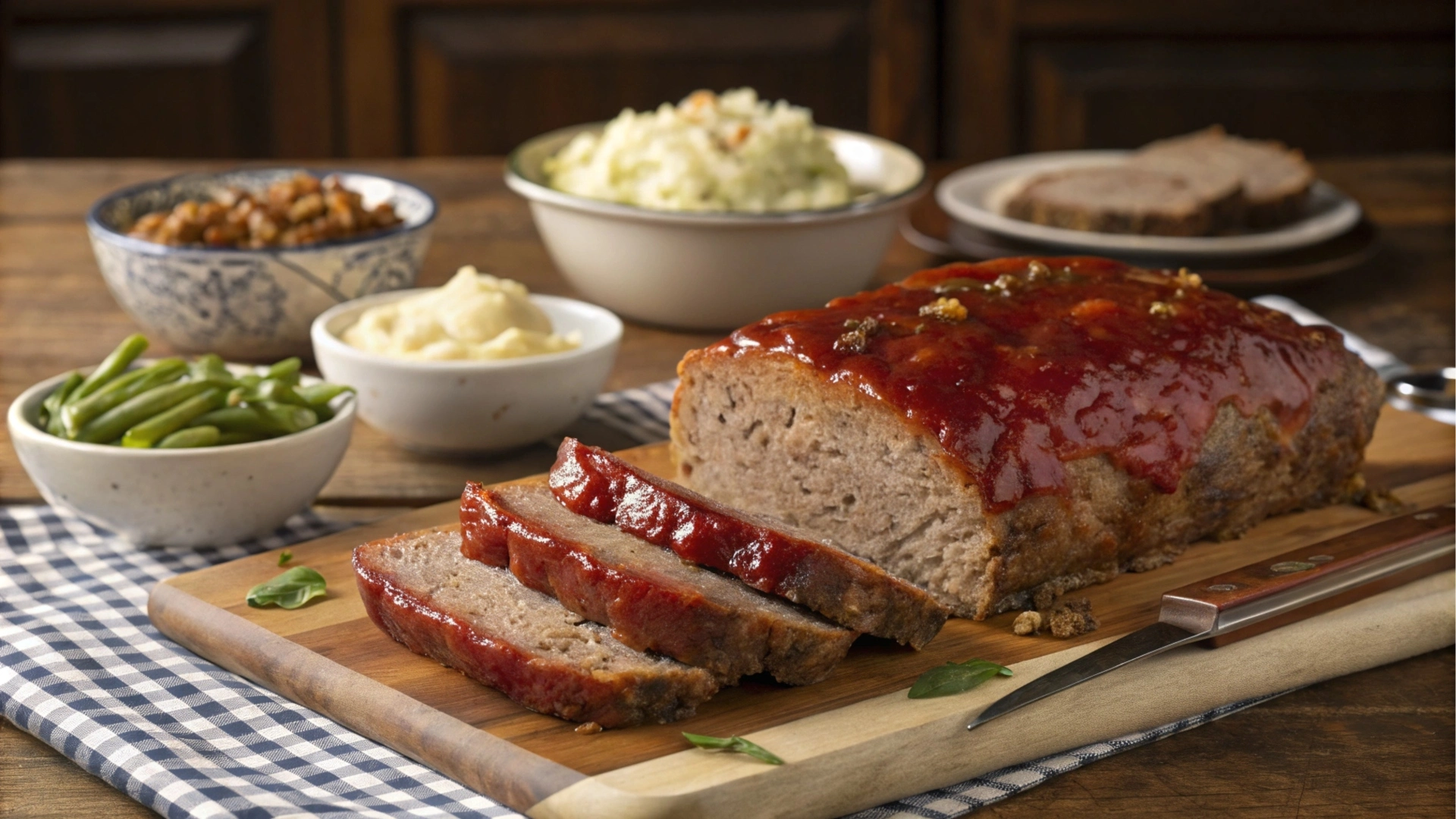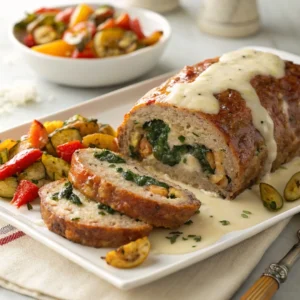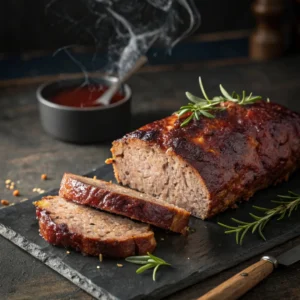Introduction
The McCormick meatloaf recipe is a timeless classic, delivering rich flavor and comfort to family dinner tables for generations. With its perfectly blended seasonings like onion powder, garlic powder, and black pepper, this traditional meatloaf combines simplicity and hearty goodness. Whether you’re preparing a quick weeknight meal or a special Sunday dinner, McCormick’s meatloaf seasoning mix ensures consistent, delicious results every time. Easy to customize with vegetables, alternative meats, or unique glazes, this homemade meatloaf recipe is a versatile favorite for any occasion.
 McCormick’s signature seasoning mix elevates the classic meatloaf recipe, delivering the perfect balance of savory spices and rich taste. Whether served with mashed potatoes, roasted vegetables, or a tangy glaze, meatloaf remains a symbol of home-cooked warmth and wholesome goodness.
McCormick’s signature seasoning mix elevates the classic meatloaf recipe, delivering the perfect balance of savory spices and rich taste. Whether served with mashed potatoes, roasted vegetables, or a tangy glaze, meatloaf remains a symbol of home-cooked warmth and wholesome goodness.
History of McCormick Meatloaf Recipe
 Meatloaf has a rich history that spans centuries, evolving through cultural traditions and regional influences. Its origins can be traced back to ancient Rome, where a similar dish was documented in Apicius, one of the oldest known cookbooks. The Romans combined minced meat with bread, wine, and seasonings, laying the foundation for what would become meatloaf. This concept of mixing ground meat with fillers traveled through Europe, where it adapted to local ingredients and culinary preferences.
Meatloaf has a rich history that spans centuries, evolving through cultural traditions and regional influences. Its origins can be traced back to ancient Rome, where a similar dish was documented in Apicius, one of the oldest known cookbooks. The Romans combined minced meat with bread, wine, and seasonings, laying the foundation for what would become meatloaf. This concept of mixing ground meat with fillers traveled through Europe, where it adapted to local ingredients and culinary preferences.
In Germany, meat-based dishes like Leberkäse emerged, while in Scandinavia, färsbröd became a beloved variation. These early versions incorporated simple seasonings and grains, making them economical and accessible. By the 19th century, European immigrants brought their recipes to America, where meatloaf became a staple. It gained popularity during the Great Depression and World War II, when stretching ingredients like ground beef with breadcrumbs, oats, or vegetables was essential for families on tight budgets.
The modern American meatloaf emerged as a versatile and affordable dish, often topped with ketchup or a savory glaze. Today, meatloaf remains a symbol of resourcefulness and comfort, continuously reinvented to suit contemporary tastes while preserving its nostalgic charm.
Overview of McCormick’s Traditional Meatloaf Recipe
The McCormick meatloaf recipe is designed for simplicity and consistent results. It uses McCormick’s expertly blended spices, creating a flavorful meatloaf that’s perfect for any occasion.. At the heart of the recipe is McCormick’s Meatloaf Seasoning Mix, which provides a perfectly balanced blend of savory herbs and spices, eliminating the need for multiple individual seasonings.
The recipe typically combines ground beef, breadcrumbs, eggs, and a touch of milk to create a tender, moist texture. A generous layer of ketchup or glaze is often spread on top before baking, adding a tangy and slightly sweet finish. The result is a meatloaf that’s juicy, flavorful, and perfect for serving with classic sides like mashed potatoes and green beans.
Easy to follow and family-friendly, McCormick’s version simplifies the cooking process while ensuring consistent, delicious results every time.
Detailed Ingredient Breakdown
3.1 Choosing the Right Ground Beef for a Juicy Meatloaf
The choice of ground beef is crucial for achieving the perfect texture and flavor in meatloaf. For a moist and tender result, an 80/20 ground beef blend (80% lean meat and 20% fat) is ideal. The fat content ensures juiciness without making the meatloaf greasy. Leaner options, such as 90/10, can be used for a healthier version but may result in a drier loaf. For added depth, some cooks mix ground beef with other meats like ground pork or veal, which contribute additional moisture and flavor. Selecting high-quality, fresh ground beef ensures the meatloaf has a rich and satisfying taste.
3.2 The Role of Breadcrumbs in a Traditional Meatloaf
Breadcrumbs act as a filler and binding agent, helping hold the meatloaf together while preventing it from becoming too dense. Traditional recipes use plain or Italian-style breadcrumbs for a subtle flavor boost. For a firmer texture, panko breadcrumbs can be substituted, providing a lighter and fluffier consistency. Alternatives like rolled oats, crushed crackers, or even cooked rice work well for gluten-free or budget-friendly variations. These fillers absorb excess moisture, ensuring the meatloaf remains tender and cohesive while stretching the amount of meat used, making it economical and family-friendly.
3.3 Importance of Eggs in a McCormick Meatloaf Recipe
Eggs play a pivotal role as the binding agent in meatloaf, holding the ingredients together to maintain its shape during baking. The proteins in the eggs coagulate when heated, forming a structure that stabilizes the meat mixture. Typically, two large eggs are sufficient for a 2-pound meatloaf, providing just the right amount of binding without altering the texture. In addition to their functional role, eggs contribute moisture, preventing the meatloaf from becoming crumbly or dry. For egg-free alternatives, ingredients like flaxseed mixed with water or unsweetened applesauce can serve as effective substitutes.
3.4 Flavor Boosters: McCormick Garlic Powder, Onion Powder, and Spices
McCormick’s signature seasonings—onion powder, garlic powder, and black pepper—are essential for enhancing the meatloaf’s flavor profile. Onion powder delivers a subtle, savory sweetness reminiscent of fresh onions without the added moisture, ensuring a balanced texture. Garlic powder adds a robust, earthy depth that complements the richness of the beef, enhancing the overall savory notes of the dish. Black pepper provides a gentle kick of warmth and spice, elevating the flavor without overpowering it. Together, these McCormick seasonings simplify the cooking process, offering consistent taste with minimal effort. By incorporating these pre-measured, high-quality seasonings, home cooks can achieve a perfectly seasoned meatloaf every time, saving time and effort compared to individually measuring spices.
3.5 Enhancing Flavor with French’s Tomato Ketchup
French’s Tomato Ketchup adds the finishing touch to a traditional meatloaf, providing a sweet and tangy glaze that balances the savory richness of the meat. When spread over the top of the loaf before baking, the ketchup caramelizes slightly, creating a glossy, flavorful crust. Its natural acidity enhances the other ingredients, cutting through the richness of the beef for a well-rounded taste. For variation, the ketchup can be mixed with brown sugar, Worcestershire sauce, or mustard to add complexity to the glaze. French’s high-quality ketchup ensures consistent flavor, complementing the spices and bringing a nostalgic, comforting element to every bite.
Step-by-Step Guide to Making McCormick Meatloaf
Follow these steps to make the perfect McCormick meatloaf recipe with moist and flavorful results.
4.1 Mixing Ingredients for a Moist McCormick Meatloaf
To start your McCormick meatloaf recipe, mix ground beef, breadcrumbs, eggs, and McCormick seasoning blend for the perfect texture.
The first step in preparing a perfect meatloaf is combining the ingredients thoroughly while avoiding overmixing, which can lead to a dense and tough loaf. Start by adding ground beef, breadcrumbs, McCormick seasonings, eggs, and milk to a large mixing bowl. For even distribution, beat the eggs lightly before adding them. Using your hands or a fork, gently mix the ingredients until just combined. Incorporate French’s Tomato Ketchup into the mixture to add moisture and flavor. Ensure the ingredients are evenly distributed, but stop mixing as soon as everything comes together to maintain a tender texture.
4.2 Shaping and Preparing Your Traditional Meatloaf
Shaping the meatloaf properly is key to ensuring even cooking and an appealing presentation. Transfer the mixed meatloaf ingredients onto a lightly greased baking sheet, loaf pan, or casserole dish. If shaping by hand, form the mixture into a rectangular loaf about 2 inches thick to ensure even cooking. Avoid pressing the mixture too firmly, as it may result in a dense texture. If using a loaf pan, pat the mixture down gently to fill the pan evenly. For a golden-brown crust, consider baking the meatloaf on a baking sheet instead of a pan, allowing more surface area to caramelize.
For those looking for alternative preparation methods, check out this quick stove-top meatloaf recipe for a faster cooking option.
4.3 Baking the Best McCormick Meatloaf
Preheat the oven to 375°F (190°C) before placing the meatloaf inside. Bake the loaf uncovered for about 50-60 minutes, or until the internal temperature reaches 160°F (71°C) when checked with a meat thermometer. About halfway through baking, brush a generous layer of French’s Tomato Ketchup or your chosen glaze over the top of the loaf to add flavor and a glossy finish. To prevent burning, keep an eye on the ketchup glaze during the final 10 minutes of baking. If the loaf appears to brown too quickly, tent it loosely with foil for the remainder of the cooking time.
4.4 Resting and Serving Suggestions
Once the meatloaf is fully cooked, remove it from the oven and allow it to rest for 10-15 minutes. This resting period is crucial as it allows the juices to redistribute throughout the loaf, ensuring a moist and tender result. Skipping this step can lead to the meatloaf falling apart when sliced. For serving, use a sharp knife to cut even slices and serve them warm. Pair the meatloaf with classic sides like mashed potatoes, steamed vegetables, or buttered green beans for a well-rounded meal. Leftover meatloaf can also be repurposed into sandwiches, offering a delicious second meal the next day.
Variations of McCormick Meatloaf Recipe
Customize your McCormick meatloaf recipe by adding vegetables, using alternative meats like turkey or pork, or trying unique glazes for a flavorful twist.
5.1 Adding Vegetables to Enhance McCormick Meatloaf
Adding vegetables to meatloaf not only enhances its nutritional value but also adds moisture and flavor. Finely chopped onions, carrots, celery, and bell peppers are popular choices that blend seamlessly into the meat mixture. For a richer texture, sauté the vegetables lightly in olive oil before incorporating them. Other options include grated zucchini or mushrooms, which add moisture and earthy flavor. Vegetables like spinach or kale can also be included for an added boost of vitamins. To ensure even cooking, make sure the vegetables are finely diced or grated, allowing them to mix evenly without overpowering the texture.
5.2 Using Ground Turkey or Pork in Your Traditional Meatloaf
While ground beef is the traditional choice for meatloaf, experimenting with other meats can bring unique flavors and textures. Combining ground pork or ground veal with beef creates a richer, more complex flavor. For a lighter alternative, ground turkey or chicken can replace beef, though these leaner meats may require additional moisture from ingredients like ketchup or milk. A mix of ground sausage can add a savory, spiced kick, while using lamb offers a unique, slightly gamey taste. Each meat variation requires monitoring the cooking time and fat content to ensure the meatloaf remains moist and tender.
5.3 Alternative Glazes to Top Your Classic Meatloaf
 The traditional ketchup glaze can be customized or replaced to suit different flavor profiles. For a sweeter finish, combine ketchup with brown sugar or honey. A tangy option can include Worcestershire sauce, Dijon mustard, and a splash of vinegar. Barbecue sauce is a popular alternative that adds smoky, bold flavors, while a teriyaki glaze or hoisin sauce offers an Asian-inspired twist. For a spicier option, mix ketchup with sriracha or hot sauce. These alternatives allow the meatloaf to take on new personalities while retaining its comforting appeal, ensuring something for every palate.
The traditional ketchup glaze can be customized or replaced to suit different flavor profiles. For a sweeter finish, combine ketchup with brown sugar or honey. A tangy option can include Worcestershire sauce, Dijon mustard, and a splash of vinegar. Barbecue sauce is a popular alternative that adds smoky, bold flavors, while a teriyaki glaze or hoisin sauce offers an Asian-inspired twist. For a spicier option, mix ketchup with sriracha or hot sauce. These alternatives allow the meatloaf to take on new personalities while retaining its comforting appeal, ensuring something for every palate.
If you love exploring classic recipes, you might also enjoy this Italian meatloaf recipe, which adds a flavorful twist with Italian herbs and seasonings.
Nutritional Information
McCormick’s traditional meatloaf offers a balanced mix of protein, fats, and carbohydrates, making it a hearty and satisfying meal. A standard serving size (about 4-5 ounces) of meatloaf contains approximately:
- Calories: 250-300
- Protein: 18-22 grams
- Fat: 12-15 grams (with 5-6 grams of saturated fat)
- Carbohydrates: 10-15 grams (primarily from breadcrumbs and ketchup)
- Sodium: 400-600 milligrams (depending on seasoning and glaze)
The dish is an excellent source of protein, iron, and essential B vitamins like B12 and niacin, which support energy production and overall health. To improve nutritional content, leaner meats or additional vegetables can be incorporated. Reducing sodium by opting for low-sodium seasonings and glazes also makes the dish healthier. Pairing meatloaf with nutrient-dense sides, such as steamed vegetables or a fresh salad, ensures a well-rounded and wholesome meal.
Tips for Moist and Flavorful McCormick Meatloaf
One key to a great McCormick meatloaf recipe is balancing moisture and flavor. Use McCormick’s seasonings and a tangy glaze to achieve perfect results
Achieving a perfectly moist and flavorful meatloaf involves a combination of the right ingredients and techniques. Here are essential tips to ensure your meatloaf stays tender and delicious:
- Choose the Right Meat: Use an 80/20 ground beef blend to retain moisture while providing flavor. Leaner meats like turkey or chicken may require additional moisture from milk, broth, or sautéed vegetables.
- Don’t Overmix the Meat: Gently mix the ingredients until just combined. Overmixing can compact the meat mixture, resulting in a dense and tough loaf.
- Incorporate Moisture-Rich Ingredients: Add ingredients like milk, ketchup, eggs, or grated vegetables to keep the meatloaf tender. Sautéed onions, mushrooms, or shredded zucchini work particularly well.
- Use a Glaze: A generous layer of ketchup, barbecue sauce, or a tangy glaze helps seal in moisture and adds flavor during baking. Apply halfway through cooking for the best results.
- Let It Rest: Allow the meatloaf to rest for 10-15 minutes after baking. This step lets the juices redistribute throughout the loaf, ensuring every bite is moist and flavorful.
By following these simple tips, you can create a meatloaf that is perfectly juicy, well-seasoned, and packed with flavor every time.
Common Mistakes to Avoid in a Traditional Meatloaf Recipe
Avoiding these common mistakes can ensure your meatloaf turns out moist, flavorful, and perfectly cooked every time:
- Overmixing the Meat: Overmixing the ingredients can result in a dense, tough meatloaf. Mix gently and stop as soon as the ingredients are evenly combined.
- Using Lean Meat Without Adjustments: Ground beef that’s too lean (like 90/10) can lead to a dry loaf. If using lean meats like turkey or chicken, add moisture-rich ingredients such as milk, broth, or sautéed vegetables.
- Skipping the Binder: Ingredients like breadcrumbs, eggs, or oats are essential for holding the meatloaf together. Without them, the loaf may crumble and fall apart during slicing.
- Neglecting to Season Properly: Under-seasoning results in bland meatloaf. Use McCormick’s seasonings, like garlic powder, onion powder, and black pepper, to add depth and balance to the flavors.
- Skipping the Resting Step: Cutting into the meatloaf too soon causes the juices to run out, leaving it dry. Let the meatloaf rest for 10-15 minutes to allow the juices to redistribute.
- Overcooking: Overbaking can dry out the meatloaf. Use a thermometer to check the internal temperature, ensuring it reaches 160°F (71°C) but no higher.
By avoiding these mistakes, you’ll ensure your meatloaf remains moist, tender, and full of flavor every time you make it.
Serving Suggestions and Side Dishes
The McCormick meatloaf recipe pairs perfectly with classic sides like mashed potatoes, green beans, or buttered corn for a comforting meal.
A classic meatloaf pairs perfectly with a variety of side dishes, offering a complete and satisfying meal. Here are some delicious serving ideas to complement your meatloaf:
- Mashed Potatoes: Creamy, buttery mashed potatoes are the ultimate comfort food pairing for meatloaf. Add garlic or chives for extra flavor.
- Steamed or Roasted Vegetables: Serve your meatloaf with a side of green beans, broccoli, carrots, or roasted Brussels sprouts. Roasting vegetables with olive oil and herbs adds a crispy, flavorful contrast to the tender meatloaf.
- Macaroni and Cheese: Rich and cheesy macaroni perfectly complements the savory flavors of meatloaf, creating a family-favorite comfort meal.
- Rice or Quinoa: Light, fluffy rice or nutty quinoa works well for a lighter, gluten-free option while soaking up the meatloaf’s juices and glaze.
- Side Salad: A fresh salad with mixed greens, tomatoes, cucumbers, and a light vinaigrette balances the richness of meatloaf and adds a refreshing crunch.
- Buttered Corn or Peas: Simple sides like sweet corn or peas, lightly tossed with butter, are quick, easy, and a classic pairing.
By pairing meatloaf with these sides, you can create a balanced, satisfying meal that’s both comforting and flavorful for any occasion.
Storing and Reheating Leftovers
Leftover portions of your McCormick meatloaf recipe can be refrigerated for 3-4 days or frozen for up to 3 months for a quick and delicious meal.
Properly storing and reheating leftover meatloaf ensures it remains moist and flavorful for future meals.
- Storing Leftovers:
- Allow the meatloaf to cool to room temperature before storing.
- Wrap individual slices or the entire loaf tightly in plastic wrap or aluminum foil.
- Place it in an airtight container and refrigerate for up to 3-4 days. For longer storage, freeze the meatloaf for up to 3 months by wrapping it securely and placing it in a freezer-safe bag.
- Reheating Instructions:
- In the Oven: Preheat the oven to 350°F (175°C). Place slices or the whole loaf in a baking dish, cover with foil to prevent drying, and heat for 20-25 minutes.
- In the Microwave: Place slices on a microwave-safe plate, cover with a damp paper towel, and heat in 30-second intervals until warmed through.
- On the Stovetop: Reheat slices in a skillet over low heat with a bit of water or broth to maintain moisture.
These methods ensure your leftover meatloaf remains tender, juicy, and just as delicious as when it was first served.
Frequently Asked Questions (FAQs)
What is in McCormick Meat Loaf Seasoning?
McCormick Meat Loaf Seasoning is a carefully blended mix of spices and flavor enhancers to simplify meatloaf preparation while delivering consistent taste. It typically includes:
- Onion powder for a subtle sweetness and savory depth.
- Garlic powder to add a rich, robust flavor.
- Black pepper for a touch of warmth and spice.
- Salt to balance and enhance the other flavors.
- Additional herbs like parsley and paprika may be included to elevate the seasoning further. This combination ensures a flavorful meatloaf without needing to measure individual spices.
Is it better to cook meatloaf at 350 or 375?
Both temperatures can work, but 375°F (190°C) is generally preferred for a perfectly cooked meatloaf. Cooking at 375°F allows the meatloaf to cook evenly and develop a caramelized crust without drying out. At 350°F, the cooking process is slower, which can sometimes help retain moisture, but it may take longer. The key is to cook the meatloaf until the internal temperature reaches 160°F (71°C) for safe consumption.
What is the secret to a great meatloaf?
The secret to a great meatloaf lies in a few essential factors:
- Proper Moisture Balance: Add ingredients like milk, ketchup, or sautéed vegetables to keep the meatloaf juicy.
- The Right Fat Content: Use ground beef with 80/20 fat content to maintain flavor and tenderness.
- Don’t Overmix: Mix ingredients gently to avoid a dense, tough texture.
- Seasoning: Use flavorful seasonings like McCormick’s Meat Loaf Mix for consistent, well-rounded taste.
- A Perfect Glaze: A tangy ketchup or barbecue glaze adds flavor and a caramelized finish.
What does adding an extra egg to meatloaf do?
Adding an extra egg to meatloaf can improve its texture and binding. Eggs act as a binder, helping hold the meat and other ingredients together during cooking. Adding an extra egg results in a more cohesive and slightly richer loaf, as the proteins in the eggs firm up when cooked. However, too many eggs can make the meatloaf overly dense or rubbery, so the general rule is one egg per pound of meat for optimal results.
Conclusion
Meatloaf remains a timeless, comforting dish that brings families together with its hearty flavors and simple preparation. By following McCormick’s traditional recipe and using high-quality ingredients like their seasoning blends, you can achieve a moist, flavorful, and perfectly cooked meatloaf every time. Whether you stick to the classic version or experiment with variations like incorporating vegetables, alternative meats, or unique glazes, meatloaf’s versatility ensures it suits every taste and occasion.
With proper techniques for mixing, shaping, baking, and serving, along with tips for avoiding common mistakes, this beloved dish becomes both easy to prepare and consistently satisfying. Perfect for busy weeknights or special family meals, meatloaf continues to hold its place as a staple of home-cooked comfort and culinary tradition.
For more meatloaf variations, don’t miss the ultimate Lipton meatloaf recipe to add to your collection.

2 thoughts on “McCormick Meatloaf Recipe”